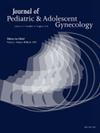26. 宫内节育器延迟性超敏反应
IF 1.7
4区 医学
Q3 OBSTETRICS & GYNECOLOGY
引用次数: 0
摘要
背景免疫介导的超敏反应已被证明是对内源性和外源性孕酮的反应,包括含左炔诺孕酮的宫内节育器(IUD),反应范围从荨麻疹到血管性水肿和过敏反应。通常,黄体酮反应被描述为急性或慢性发作,症状持续时间长。本病例将讨论一个独特的发病时间线和症状进展。病例1:22岁患者就诊3天,瘙痒、灼烧和刺痛加重。为了长期治疗子宫内膜异位症,患者在放置月环内节育器6.5周后,于当天早上由她的儿科青少年妇科医生(PAG)随访。她服用口服避孕药Lo Loestrin已经一年多了,而宫内节育器还在原位。PAG决定不取出宫内节育器,因为症状仍然轻微,等待过敏专科医生的意见,以评估其他原因。症状在一天中不断恶化,包括上肢和下肢肿胀,将她带到急诊科,当时她服用抗组胺药出院。然而,肿胀继续恶化,24小时后她回到急诊科。体格检查以面部、手掌和脚底黄斑丘疹红斑和水肿为主。立即取出宫内节育器,给予舒美劳和苯海拉明治疗,症状好转。患者使用强的松出院,随后3天症状消失。门诊免疫学家随访确定病例与宫内节育器外源性孕酮的延迟超敏反应一致。取出宫内节育器后,她没有再出现症状。评论:虽然没有绝对的证据表明宫内节育器是她急性瘙痒和水肿的唯一原因,但与宫内节育器的插入和取出有关,症状的发生和缓解之间有很强的相关性。有记录的黄体酮过敏反应的病例有一个时间表,通常分为两类。第一种是急性症状出现在宫内节育器插入几天内,第二种是慢性症状出现在几个月后,持续数年。该病例显示了基于黄体酮的宫内节育器反应的不同寻常的时间轴,在插入后6周出现急性症状,几天内进展为严重症状。认识到对宫内节育器的过敏反应可能在这个时间线发生,并升级为可能危及生命的过敏反应是至关重要的,因为去除宫内节育器的过敏原是治疗方法。本文章由计算机程序翻译,如有差异,请以英文原文为准。
26. Delayed hypersensitivity reaction to Mirena IUD
Background
Immune-mediated hypersensitivity reactions have been documented in response to endogenous and exogenous progesterone including the levonorgestrel-containing intrauterine device (IUD), with reactions ranging from urticaria to angioedema and anaphylaxis. Typically, reactions to progesterone have been described as acute or chronic in onset with long lasting symptoms. This case will discuss a unique timeline of onset and symptom progression.
Case
A 22-year-old patient presented to the ED with 3 days of worsening itching, burning and tingling. The patient had been seen that morning by her Pediatric Adolescent Gynecologist (PAG) for follow up 6.5 weeks after placement of a Mirena IUD for long-term management of endometriosis. She had been on the oral contraceptive pill Lo Loestrin for over one year, while IUD in situ. PAG decided not to remove IUD since symptoms were still mild, pending input from allergist for evaluation of alternate causes. Symptoms progressed throughout the day to include upper and lower extremity swelling bringing her to the ED, at which time she was discharged with antihistamines. However, swelling continued to worsen and she returned to ED 24 hours later. Physical exam was notable for maculopapular erythema and edema to the face palms and soles of feet. IUD was removed immediately, and patient was treated with Solu-Medrol and Benadryl with symptomatic improvement. She was discharged to home with prednisone, and symptoms resolved over the next 3 days. Follow up with outpatient immunologist determined case to be consistent with delayed hypersensitivity reaction in response to exogenous progesterone from the IUD. She has had no recurrence of symptoms since the IUD was removed.
Comments
While there is no absolute confirmation that the IUD was the sole cause of her acute pruritus and edema, there is a strong correlation between symptom onset and resolution relative to IUD insertion and removal. Documented cases of hypersensitive reactions in response to progesterone exposure have a timeline that generally fall within 2 categories. First is acute symptom onset appearing within several days of IUD insertion or second, chronic symptoms appearing months later and lasting years. This case illustrates an unusual timeline of progesterone-based IUD reaction with acute onset of symptoms 6 weeks after insertion progression within days to severe symptoms. Recognizing that an allergic reaction to a Mirena IUD can occur in this timeline and escalate to potentially life-threatening anaphylaxis is crucial since removing the Mirena IUD allergen is the cure.
求助全文
通过发布文献求助,成功后即可免费获取论文全文。
去求助
来源期刊
CiteScore
3.90
自引率
11.10%
发文量
251
审稿时长
57 days
期刊介绍:
Journal of Pediatric and Adolescent Gynecology includes all aspects of clinical and basic science research in pediatric and adolescent gynecology. The Journal draws on expertise from a variety of disciplines including pediatrics, obstetrics and gynecology, reproduction and gynecology, reproductive and pediatric endocrinology, genetics, and molecular biology.
The Journal of Pediatric and Adolescent Gynecology features original studies, review articles, book and literature reviews, letters to the editor, and communications in brief. It is an essential resource for the libraries of OB/GYN specialists, as well as pediatricians and primary care physicians.

 求助内容:
求助内容: 应助结果提醒方式:
应助结果提醒方式:


